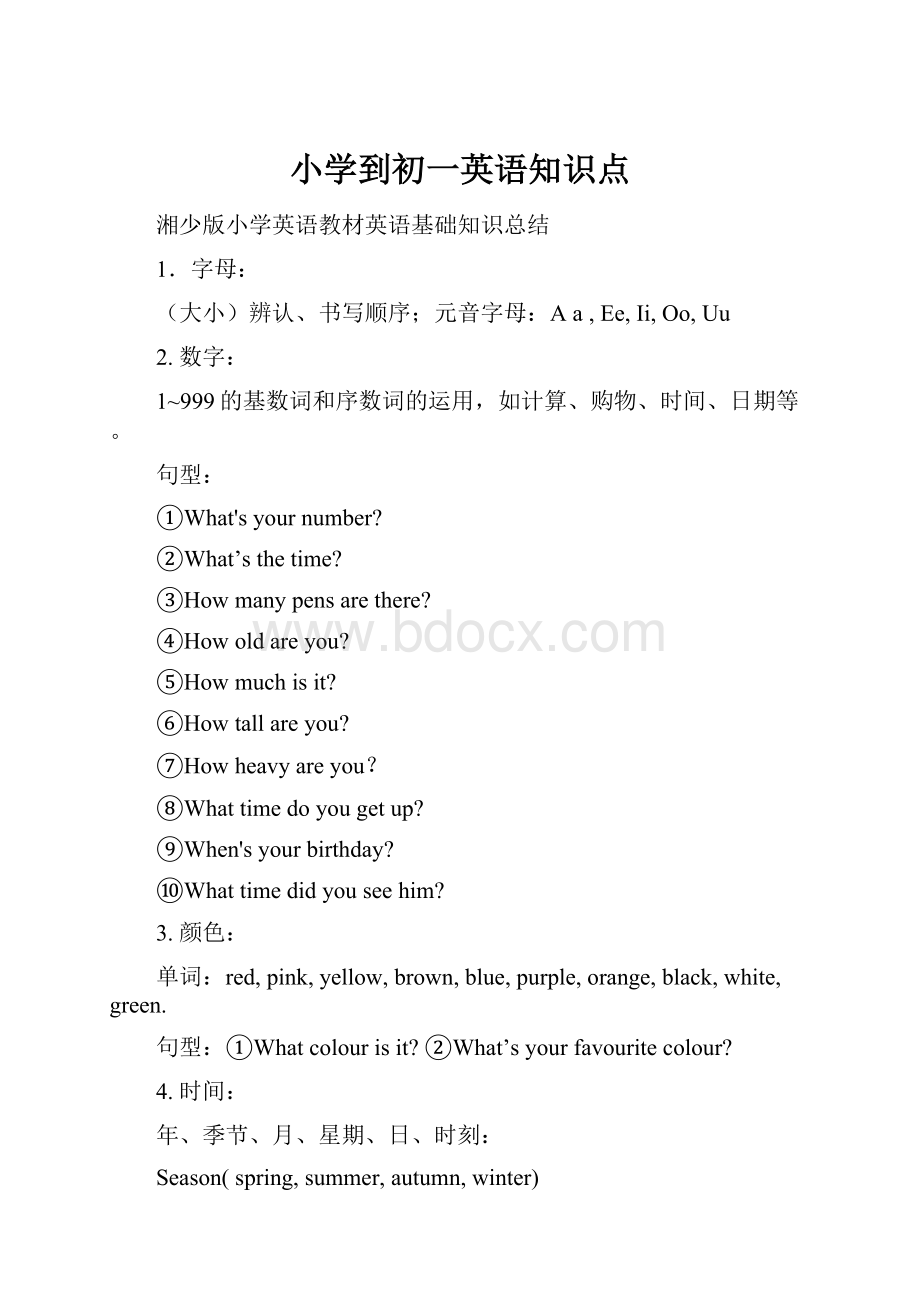 小学到初一英语知识点.docx
小学到初一英语知识点.docx
- 文档编号:12055384
- 上传时间:2023-04-16
- 格式:DOCX
- 页数:22
- 大小:25.92KB
小学到初一英语知识点.docx
《小学到初一英语知识点.docx》由会员分享,可在线阅读,更多相关《小学到初一英语知识点.docx(22页珍藏版)》请在冰豆网上搜索。

小学到初一英语知识点
湘少版小学英语教材英语基础知识总结
1.字母:
(大小)辨认、书写顺序;元音字母:
Aa,Ee,Ii,Oo,Uu
2.数字:
1~999的基数词和序数词的运用,如计算、购物、时间、日期等。
句型:
①What'syournumber?
②What’sthetime?
③Howmanypensarethere?
④Howoldareyou?
⑤Howmuchisit?
⑥Howtallareyou?
⑦Howheavyareyou?
⑧Whattimedoyougetup?
⑨When'syourbirthday?
⑩Whattimedidyouseehim?
3.颜色:
单词:
red,pink,yellow,brown,blue,purple,orange,black,white,green.
句型:
①Whatcolourisit?
②What’syourfavouritecolour?
4.时间:
年、季节、月、星期、日、时刻:
Season(spring,summer,autumn,winter)
Month:
January,February,March,April,May,June,July,August,September,October,November,December.
Week:
Sunday,Monday,Tuesday,Wednesday,Thursday,Friday,Saturday.
Day:
1stMay(thefirstofMay),May2nd(Maythesecond)
句型:
见话题2。
5.食品与饮料:
人对食品与饮料的喜好;东西方食品。
句型:
①Ilikebiscuits.
②I’dlikeacolddrink.
③Wouldyoulikesomebuns?
④Doyouwantsomerice?
⑤Thisisn’tmyfood.
6.服装:
服装的颜色:
人对服装的喜好;某人的穿戴;所属关系;位置等。
句型:
①IlikethegreenT-shirt.
②Where’smynewcap?
③Who’sshirtisthis?
④Isthisyourhat?
7.物品:
名词的单、复数;特点、颜色、所属关系;
存在的位置(in,on,under,beside,behind,infrontof,above,near,inside,outside)。
玩具(toycar,doll,)
文具(desk,book,bag,pen,pencil,pencil-box,ruler,pencilsharpener,)
句型:
①What’sthis?
②Whatcolourisit?
③Whoseisthis?
④Thisismybrother’spainting.
⑤Ihaveapuppet.
⑥There'sacarnearthehospital.
⑦Wasitinthewardrobe?
⑧Isthereabookonthedesk?
⑨That'snotmine.
8.动物和植物:
cat,dog,duck,fish,sheep,bird,panda,monkey,rabbit,hen,cock,chick,tiger,lion,pig,cow,mouse(mice),elephant,ladybird,puppy,tree,flower,rose,
9.建筑与场所:
factory,hospital,park,house,library,museum,office,farm,postoffice,bank,policestation,railwaystation,bookstore,school,classroom,skatingrink,café,house(bathroom,living-room,sitting-room,bedroom,kitchen),garden…
10.身体:
head,hair,eye,nose,ear,mouth,neck,hand,finger,foot(feet),toe…外貌:
fat,thin,tall,short,old,young,twobigblueeyes,longhair,shorthair,blackhair.句型:
①Thisismynose.
②Touchyourhead.
③Raiseyourarm.
11.个人情况:
姓名、年龄、地址、特点与爱好。
句型:
①I'mtwelveyearsold.
②Myhobbyisreading.
③Ilikemusic.
④I'minterestedinspace.
⑤MynameisPeter.
⑥I'mtallandthin.
⑦Doyouhaveanyhobbies?
12.家庭、亲属和朋友:
姓名、年龄、地址、职业、特点与爱好、与你的关系
family,grandfather(grandpa/granddad),grandmother(grandma/grandmum),father,mother,brother,sister,uncle,aunt,cousin,friend.
句型:
①Who'she?
He'smyfather.
②He'sadoctor
③Helikesplayinggames.
④Myfatherhelpsme.
⑤Isheasoldier?
⑥What’she?
13.学校:
学校建筑和学校生活。
school,classroom,library,playground,Chinese,maths,English,music,computer,PE,art,science,
句型:
①Whendoyougotoschool?
②WhattimedoyouhaveEnglish?
14.情绪和身体状态:
happy,sad,tired,angry,shy,sorry,well,sick,
句型:
①I'msick.②I'mhappy.③Wearesorry.④Ifeelsad.
15.社交礼仪:
礼貌用语;询问与应答。
句型:
问候
①Hello./Hi.
②Goodmorning/afternoon/evening.③Howareyou?
④Howdoyoudo?
⑤Gladtomeetyou./Nicetomeetyou.
介绍①Mynameis…②I’mapupil.③I’m12.④Thisisourteacher,MissChen.⑤HeisfromJapan.
道别①Goodbye./Bye.②Seeyou.③Goodnight.
道谢①Thankyou./Thanks.②You’rewelcome.
道歉①Sorry.②I’msorry.③Excuseme.
请求①CanIhaveapuppy?
②CanIborrowapencil?
③Yes,please.④Ofcourse.
祝愿①Happybirthday.②MerryChristmas.
提供帮助①CanIhelpyou?
②WhatcanIdoforyou?
③What’sthematter?
寻求帮助和建议①WhatcanIdo?
用餐①Doyouwantsomesoup?
②Wouldyoulikesomerice?
③I'dlikeacolddrink.
购物①Whichonedoyouwant?
②CanIlookatit?
③Iwantaredone,please.④It'stooexpensive.⑤Haveyougotenoughmoney?
⑥Howmuchisit?
16.国家与国庆日:
China,Japan,America(theUSA),English(theUK),Australia,Russia,Canada,Singapore,India,France,
句型:
①When’syourcountry’sNationalDay?
②IcomefromChina.
17.天气与气候特征:
hot,cold,cool,warm,sun,sunny,rain,heavyrain,rainy,wind,strongwind,windy,snow,heavysnow,cloud,cloudy,…
句型:
①What'stheweatherlike?
②It’sacoldday.
③Springiswarmandnice.
④Tomorrowwillberainy.
⑤Ilikeasunnyday.
18.节日:
节日的特点;节日的活动。
NewYear'sDay,SpringFestival,Children'sDay,Mid-autumnFestival,Teachers'Day,NationalDay,ChristmasDay,DragonBoatFestival.
19.正在发生的事情:
现在进行的动作和发生的事。
句型:
①Areyoumakingakite?
②Peteriswriting.
③What'sAnnedoing?
④Whereareyougoing?
⑤Whataretheydoing?
⑥Isherunning?
20.日常生活:
日常生活、工作、学习的活动。
句型:
①Icometoschoolbybus.
②Yourhomeworkisgood.
③Whattimedoyougetup?
④Shealwaysgetupearly.
21.计划与打算:
计划和将要进行的动作begoingtodo…
句型:
①I’m/You’re/He’s/She’s/We’re/They’re(not)goingtoswim.
②Areyougoingtoswim?
③Ishe/shegoingtovisitAnne?
④Whatareyougoingtodo?
⑤Whatishegoingtodo?
⑥Whenaretheygoingtoswim?
⑦Tomorrowwillberainy.
⑧I'llstayathome.
22.能力和可能:
能做某事或可能进行某事。
句型:
①CanyoureadandwriteinEnglish?
②CanIhaveapuppy?
③Whatcanyoudo?
④Shecanrunfast.
23.过去发生的事情或过去的打算:
过去式。
句型:
①Wherewereyou?
②Whowasfirst?
③Wasitinthewardrobe?
④Bennytookmyball.
⑤Wheredidyougo?
⑥Whatdidyoudo?
⑦Icamebyplane.
⑧Annewantedtoskate.
24.对事物的比较:
比较级和最高级。
句型:
①Mysingingislouderthanyours.
②I’mtallerthanyou.
③TheremoreshopsinPictureOne.
④Somestoriesaremoreinterestingthanothers.
⑤Themostinterestingstories.⑥Whoisfatter?
25.提醒与告示:
①Whatdoesthatsignmean?
②Drawacatontheroof.
③Don'tputyourfeetontheseat.
④Nospeaking.
⑤Donotgoin.
26.擅长和喜欢的事情:
①I'm/You're/He'sgoodatdrawing.
②Ilikeplayingbasketball.
七年级英语湘教版上册
英语知识点总结与测试题
【知识梳理】
I.重点短语
1.Sitdown
2.onduty
3.inEnglish
4.haveaseat
5.athome
6.looklike
7.lookat
8.havealook
9.comeon
10.atwork
11.atschool
12.puton
13.lookafter
14.getup
15.goshopping
II.重要句型
1.helpsb.dosth.
2.Whatabout…?
3.Let’sdosth.
4.It’stimetodosth.
5.It’stimefor…
6.What’s…?
Itis…/It’s…
7.Whereis…?
It’s….
8.Howoldareyou?
I’m….
9.Whatclassareyouin?
I’min….
10.Welcometo….
11.What’s…plus…?
It’s….
12.Ithink…
13.Who’sthis?
Thisis….
14.Whatcanyousee?
Icansee….
15.Thereis(are)….
16.Whatcolourisit(arethey)?
It’s(They’re)…
17.Whose…isthis?
It’s….
18.Whattimeisit?
It’s….
III.交际用语
1.Goodmorning,Miss/Mr….
2.Hello!
Hi!
3.Nicetomeetyou.Nicetomeetyou,too.
4.Howareyou?
I’mfine,thankyou/thanks.Andyou?
5.Seeyou.Seeyoulater.
6.Thankyou!
You’rewelcome.
7.Goodbye!
Bye!
8.What’syourname?
Mynameis….
9.Hereyouare.Thisway,please.
10.Who’sondutytoday?
11.Let’sdo.
12.Letmesee.
IV.重要语法
1.动词be的用法;
2.人称代词和物主代词的用法;
3.名词的单复数和所有格的用法;
4.冠词的基本用法;
5.Therebe句型的用法。
【名师讲解】
1.in/on
在表示空间位置时,in表示在某个空间的范围以内,on表示在某一个物体的表面之上。
例如:
Thereisabirdinthetree.树上有只鸟。
Thereisapictureonthewall.墙上有张图。
2.this/that/these/those
(1)this常常用来指在时间、地点上更接近讲话人的人和事,these是this的复数形式。
that常常用来指在时间、地点上离讲话人更远一点的人和事,those时that的复数形式。
例如:
YoulookinthisboxandI’lllookinthatoneoverthere.你看看这个盒子,我去看那边的那个盒子。
Iwantthiscar,notthatcar.我想要这辆小汽车,不是那一辆。
Takethesebookstohisroom,please.请把这些书拿到他房间去。
Thisismine;that’syours.这个是我的,那个是你的。
Theseareapples;thoseareoranges.这些是苹果,那些是橘子。
(2)在打电话的用语中,this常常指的是我,that常常指的是对方。
例如:
ThisisMaryspeaking.Who’sthat?
我是玛丽。
你是谁?
3.Therebe/have
Therebe"有",其确切含意为"某处或某时存在某人或某物。
"其结构是:
Therebe+某人或某物+表示地点或时间的状语。
Therebe后面的名词实际上是主语,be动词的形式要和主语在数上保持一致,be动词后面的名词是单数或不可数名词时用is,名词是复数时用are。
例如:
(1)Thereisabigbottleofcokeonthetable.桌上有一大瓶子可乐。
(2)Thereisadollinthebox.那个盒子里有个娃娃。
(3)Therearemanyapplesonthetree.那树上有许多苹果。
总之,Therebe结构强调的是一种客观存在的"有"。
have表示"拥有,占有,具有",即:
某人有某物(sb.have/hassth.)。
主语一般是名词或代词,与主语是所属关系。
例如:
(4)Ihavetwobrothersandonesister.我有两个兄弟,一个姐姐。
(5)Thathousehasfourrooms.那所房子有四个房间。
4.look/see/watch
(1)look表示“看、瞧”,着重指认真看,强调看的动作,表示有意识地注意看,但不一定看到,以提醒对方注意。
,如:
Look!
Thechildrenareplayingcomputergames.瞧!
孩子们在玩电脑游戏。
Look!
What’sthatoverthere?
看!
那边那个是什么?
单独使用是不及物动词,如强调看某人/物,其后接介词at,才能带宾语,如:
He’slookingatme。
他正在看着我。
(2)see强调“看”的结果,着重的是look这个动作的结果,意思是“看到”,see是及物动词,后面能直接跟宾语。
如:
Whatcanyouseeinthepicture?
你能在图上看到什么?
Lookattheblackboard.Whatdidyouseeonit?
看黑板!
你看到了什么?
(3)watch“观看,注视”,侧重于场面,表示全神贯注地观看、观察或注视某事务的活动,强调过程,常用于“看电视、看足球、看演出”等。
如:
YesterdaywewatchedafootballmatchonTV.昨天我们从电视上看了一场足球比赛。
4.puton//in
puton意为“穿上,戴上”。
主要指“穿上”这一动作,后面接表示服装、鞋帽的名词。
in是介词,表示“穿着”强调状态。
在句中可以做定语、标语和状语。
如:
It’scoldoutside,putonyourcoat.外面冷,穿上你的外衣。
Heputsonhishatandgoesout.他戴上帽子,走了出去。
ThewomaninawhiteblouseisJohn’smother.穿白色衬衣的那个妇女是John的妈妈。
5.house/home/family
house:
“房子”,指居住的建筑物;Home:
“家”,指一个人同家人共同经常居住的地方;Family:
“家庭“,“家庭成员”。
例如:
Pleasecometomyhousethisafternoon.今天下午请到我家来。
Heisnotathome.他不在家。
Myfamilyallgetupearly.我们全家都起得很早。
6.fine,nice,good,well
四者都可用作形容词表示"好"之意,但前三者既可作表语又可作定语,而后者仅用作表语。
主要区别在于:
(1)fine指物时表示的是质量上的"精细",形容人时表示的是"身体健康",也
可以用来指"天气晴朗"。
例如:
Yourparentsareveryfine.你父母身体很健康。
That'safinemachine.那是一台很好的机器。
It'safinedayforawalktoday.今天是散步的好时候。
(2)nice主要侧重于人或物的外表,有"美好","漂亮"的意思,也可用于问候或赞扬别人。
例如:
Lucylooksnice.露西看上去很漂亮。
Thesecoatsareverynice.那些裙子很好看。
Nicetomeetyou.见到你很高兴。
It'sveryniceofyou.你真好。
(3)good形容人时指"品德好",形容物时指"质量好",是表示人或物各方面都好的普通用语。
例如:
Hersonisagoodstudent.她儿子是一个好学生。
Theredcarisverygood.那辆红色小汽车很好。
(4)well只可用来形容人的"身体好",但不能作定语,它也能用作副词作状语,多放在所修饰的动词之后。
例如:
I'mverywell,thanks.我身体很好,谢谢。
Myfriendssingwell.我的朋友们歌唱得好。
【考点扫描】
中考考点在本单元主要集中在:
1.动词be的用法;
2.人称代词和物主代词的用法;
3.名词的单复数和所有格的用法;
4.冠词的基本用法;
5.Therebe句型的用法。
6.本单元学过的词汇、短语和句型;
7.本单元学过的日常交际用语。
考试形式可以是单项填空、完型填空、短文填空、完成句子。
【中考范例】
1.(2004年北京市中考试题)
Mary,pleaseshow________yourpicture.
A.myB.mineC.ID.me
【解析】答案:
D。
该题考查的是人称代词和物
- 配套讲稿:
如PPT文件的首页显示word图标,表示该PPT已包含配套word讲稿。双击word图标可打开word文档。
- 特殊限制:
部分文档作品中含有的国旗、国徽等图片,仅作为作品整体效果示例展示,禁止商用。设计者仅对作品中独创性部分享有著作权。
- 关 键 词:
- 小学 初一英语 知识点
 冰豆网所有资源均是用户自行上传分享,仅供网友学习交流,未经上传用户书面授权,请勿作他用。
冰豆网所有资源均是用户自行上传分享,仅供网友学习交流,未经上传用户书面授权,请勿作他用。


 铝散热器项目年度预算报告.docx
铝散热器项目年度预算报告.docx
